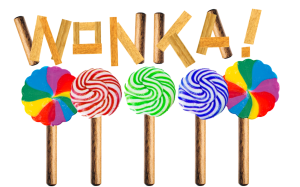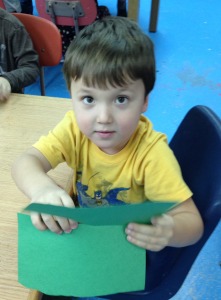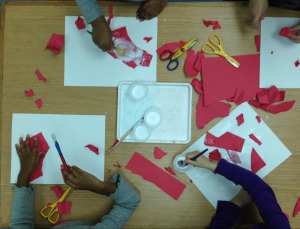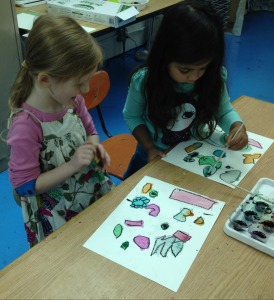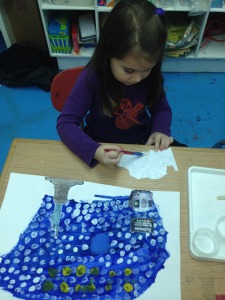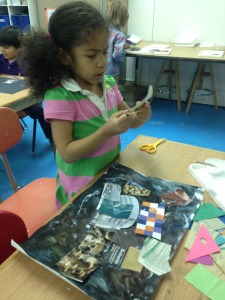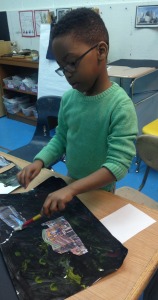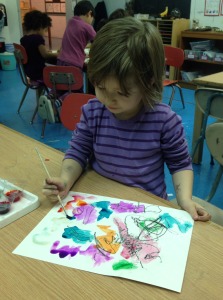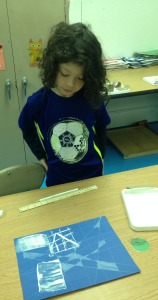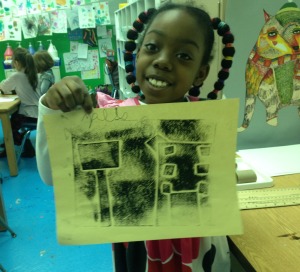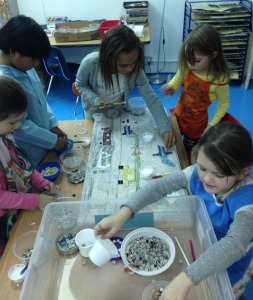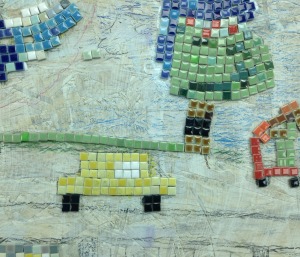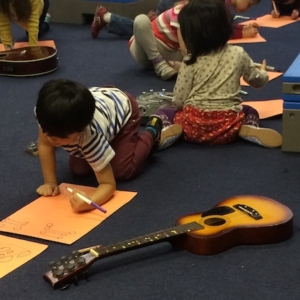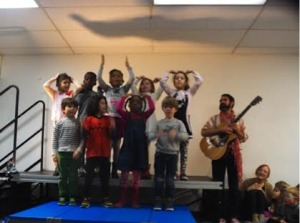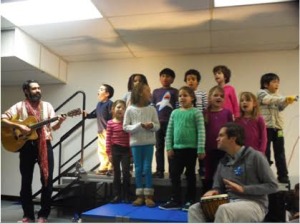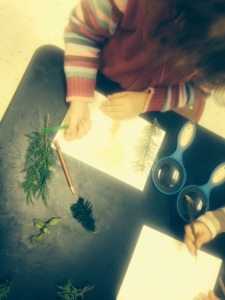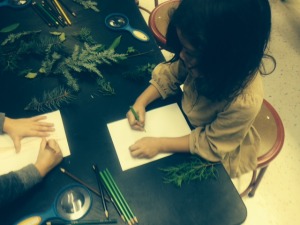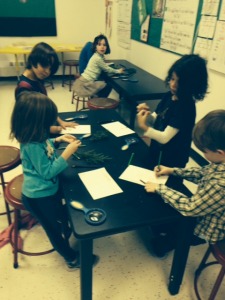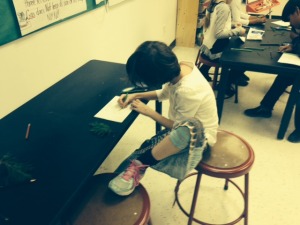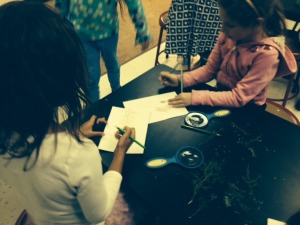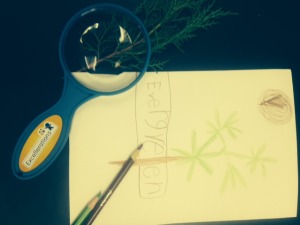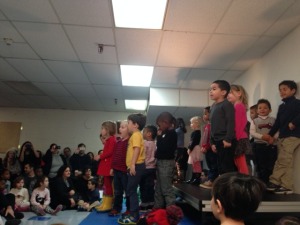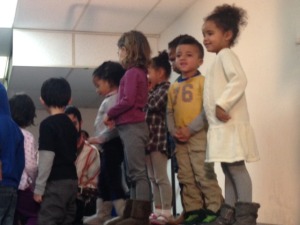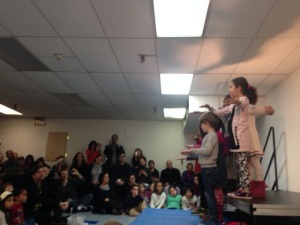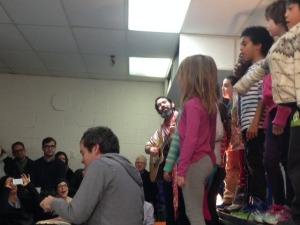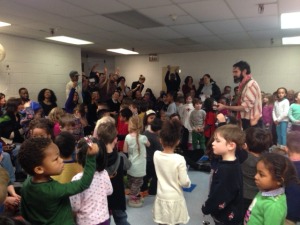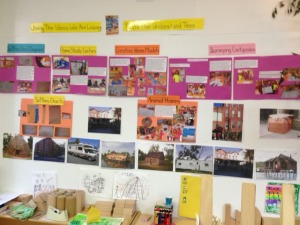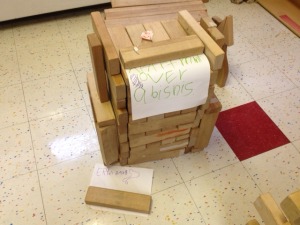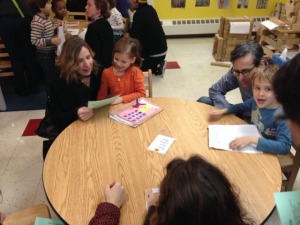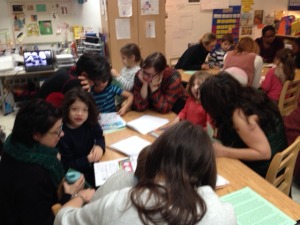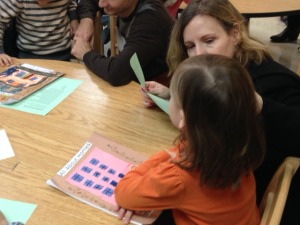Our elementary school students have so many amazing specials. Here is the October update from our special teachers:
SCIENCE WITH NICOLE!
Dear Co-op School Families, I cannot believe it is December already! I hope everyone enjoyed a fun and relaxing Thanksgiving with family and friends. November was another exciting month in the Science Lab. The children worked in the lab with more independence and they have been really involved in their fall studies.
Prekindergarten The Beetles, Dragonflies and Bumblebees wrapped up their hermit crab observations just as Mermie and Permie decided they were ready to molt. Currently they are both under the sand growing successfully. The Pre-K has moved on to a study of snails. We first read What Lives In A Shell, by Zoehfeld and Davie. The children looked at shells and discussed where the shells that hermit crabs inhabit come from. Snails are especially interesting after learning about hermit crabs, because they are shell makers! A few Co-op students found and generously donated some super cute snails to live in our Co-op School snail habitat! We have sixteen land snails and four water snails that will be wintering in the science room. The Pre-K classrooms also have some snail visitors to enjoy. The children have enjoyed reading, discussing, and observing the snails. They are learning many facts about snails: they have two eye stalks and four tentacles , they are Gastropods, they have a foot, they have an air hole and a mouth with a rough tongue, they make shells and slime, and much more. The Pre –K has also made many up-close observations holding the snails and looking at them through magnifying glasses. They have recorded their results by drawing and creating snail models.


Kindergarten (Katydids) finished up their science lab work on the Five Senses this past week and they will continue to talk about their 5 senses in writing in the classroom. In Science we read books about each of the individual senses: Sight, Taste, Hearing, Touch, Smell by Maria Rius, and then created experiments for each sense. For example after reading the book Sight, the children talked as a group about our eyes and eye color. The children looked very closely at their own eyes and each other’s eyes. Then we moved to the lab tables to use magnifying glasses to look very closely at our new snails. Each Katydid created an observational drawing to record what he learned about the snail using their sense of sight. Finally, each Katydid created a packet of their Five Senses Study lab work. This week we will begin our exciting study of out beloved planet Earth! This lab work will complement the Beautiful Things work that the Katydids are doing in their classroom. We will think about the Earth in three phases: first, we will explore basic Earth facts, then we will explore ways we can help to preserve and help our planet, and finally we will be using recycled materials to create and ecosystem that the Katydids can observe for months to come!

First Grade (Centipedes) is learning about Matter! They gathered so much information about physical and chemical reactions during the Potions unit that will help them as they explore the 3 States of Matter: Solid, Liquid, and Gas. We began our unit by brainstorming about what matter actually is. Then we read What Is Our World Made Of, by Zoehfled and Meisel. It was exciting to discover that matter is actually everything around us and we are also made of matter. In their lab work so far, the students observed water changing from liquid to solid by creating ice pops, from solid to liquid as they melted ice, and from liquid to gas as they observed the process of evaporation and condensation! The Centipedes will be creating and conducting many more experiments to observe changes in states of matter.

Second Grade (Sharks) will return to the Science Lab from their STEM workshop in 2015! I am looking forward to it! This winter and spring, the Sharks will explore the Properties of Water, Geology, and Force and Motion. Best Wishes, Nicole
———————————————————————————–
SPANISH WITH CARLA!
Kindergarten (Katydids): ¡Hola! We are continuing to have a great time in Spanish with los grillitos. We are applying and extending our vocabulary in a fun unit about the days of the week (lunes, martes, miércoles, jueves, viernes, sábado, y domingo), the current weather and the clothes we need to wear accordingly. Please support our efforts by practicing with your child––always having fun! ¡Hasta pronto!
First Grade (Centipedes): Wow! Los ciempiés and I have been learning so much about our families and our home. We are working hard on acquiring new vocabulary as well as applying and extending our previous knowledge of Spanish. Please support our efforts by practicing with your child––always having fun! Muchas gracias.
Second Grade (Sharks): Our fierce tiburones have been working purposefully, learning about homes and families. We are working hard on acquiring new vocabulary as well as applying and extending our previous knowledge of Spanish. Our efforts are leading us to the building of dos casitas de cartón: two houses using recycled materials. Please support our efforts by practicing with your child––always having fun!
———————————————————————————–
MUSIC WITH DAN
Prekindergarten The Bumblebees, Beetles and Dragonflies have been singing up a storm! In the Dragonflies classroom we wrote a song for the class fish. In the Beetles we’ve been exploring conducting – where one child is conducting at the front of the classroom, and the class has to start and stop singing based on the conductor’s hand movements. It’s a hit! The Bumblebees have been playing listening games – and recently started using rhythm sticks. So far we have tapped, scraped, hammered and drummed our sticks in rhythms of 4/4 time. The Prekindergarten classes are expanding their repertoire of sing-along songs to include “I Want To Hold Your Hand,” “This Land Is Your Land,” “Five Little Pumpkins,” “Doe A Deer” and “Subway Train and the Animal Riders.” We will be learning new songs for the Holiday Sing, memorizing them and making Jingle Bells to play during the performance.

Kindergarten The Katydids took to the roof on the last warm day for a Music Class outside. After an introduction to rhythm sticks and how to hold and play them, we conducted an experiment. Using found objects on the roof, we played our sticks on wood, metal, foam, brick and plastic. We discovered that our rhythm sticks sound different when tapped on different materials. In our classroom, the Katydids explored pitch – using our colored desk bells, we listen to three different notes, and determined which one is high, low, and in the middle. Our spotlight artist in November is Woody Guthrie, and our Katydids have been singing “This Land Is Your Land” so well that we plan to perform it at the Holiday Sing. We also began working on rhyming patterns, identifying what makes two words rhyme. We sang “Down By The Bay” and made up funny rhymes for it!

First Grade The Centipedes started our lessons in pitch with listening games. We took deep Dragon Breaths to help us focus our minds and bodies. One child would sit in a chair, blindfolded. A number of children would stand behind the chair, clapping their hands. The blindfolded person would then try to guess how many children were standing behind them. It took a tremendous amount of effort to play this game as a group, but the children delighted when their hard work and focus meant that the blindfolded child could really hear, and guess correctly. Our first graders have been studying the notes of the scale, singing “Doe A Deer” and practicing singing the major scale. Using desk bells, we identify the direction of pitch changes in a song like “Twinkle Twinkle Little Star” or “It’s Raining It’s Pouring.” We’ve also been playing our rhythm sticks. Our first graders learned a new song Dan wrote for them to sing at Town Hall, and will be singing “Let It Snow!” at the Holiday Sing.

Second Grade The Sharks have been reviewing the major scale by singing “Doe A Deer”, but have taken those notes and applied them to other songs. “Twinkle Twinkle Little Star” became “Do Do Sol Sol La La Sol.” The Sharks are working on their songs for “Charlie and The Chocolate Factory” as well as their songs for the Holiday Sing. Our lessons about pitch involved identifying three notes – high, low, and middle. We closed our eyes and when a note was played we would put our finger on either our head (high note), belly (middle note) or foot (low note). We learned a new song, “Grizzly Bear.” In the song, the leader sings a line and the chorus replies, “Grizzly Bear.” We differentiated the times when “Grizzly Bear” goes up in pitch and the times when it stays on one note. We assigned hand motions to visualize the pitch changes. We applied the notion of high, low and middle notes to the piano keyboard, and moved around our classroom – walking at different heights when different parts of the piano were played. The Sharks will be learning “Walking In A Winter Wonderland” for Holiday Sing!

——————————————————————————-
GARDENING WITH SOPHIE!
Dear Coop Families, It’s been another great month gardening at Brevoort! In gardening class we’ve built upon our prior studies and learned more about how seeds develop into plants through direct observation and art collage. Working outside in the garden, we learned how the weather affects the plants in our garden and worked together to get our garden ready for the Winter. We also did some great activities to learn about how Deciduous trees go dormant for the Winter and loose their leaves. Take care and happy gardening, Sophie
Pre-Kindergarten
The Beetles have been doing some great work in gardening class this month. The have been doing a fantastic job caring for all their classroom plants, especially their plant pet, grass seed guy. In November, we’ve built upon our prior lessons to learn more about how a seed becomes a plant through direct observation with sprouting seeds collected from our Irving garden. We even examined a dissected bean seed to learn about the different parts inside. As the days have gotten colder, we’ve learned how to care for our garden by pulling and composting the plants that have been killed by frost and also planted a couple of daffodil bulbs to bloom in the Spring. Next we moved on to our Fall leaf study and the Beetles were really excited to learn about how some trees go dormant and take a nap all Winter!. To support our learning we read Red Leaf, Yellow Leaf by Lois Ehlert. We then picked out a leaf from the Beetle collection and, using a NYC tree census and our magnifying glasses, identified the type of leaf and then illustrated our leaf using colored pencils.The Dragonflies have been doing some amazing gardening work this November. In early November we planted some daffodil and tulip bulbs in the new perennial bed in the rooftop garden and talked a bit about how we get flowers again in the Spring. In October the Dragonflies began reducing their carbon footprint in the classroom by composting their snack scraps. In November we expanded upon this composting activity to care for our garden by pulling up and composting all of the plants that have been killed by the frost, while we worked in the garden we talked about the change in seasons and how it affected all of our plants. During our indoor time during gardening class we’ve also been taking good care of our plant pet Charlie and have been learning more about how a bean seed becomes a plant through direct observation with seeds collected from the Irving garden.

It’s been great having The Bumblebees in gardening this past month. We’ve built upon our knowledge of seeds and how seeds grow through group discussion and direct observation. We even dissected a bean seed to learn about the different parts inside. In gardening class we also have been getting our hands dirty caring for the plants in the bumblebee planter and composting the ones that have been killed by frost. Next we moved on to our Fall leaf study. The Bumblebees brought in an amazing assortment of leaves and were very excited to share their knowledge about leaves! To support our learning about how Deciduous trees go dormant for the Winter we read Red Leaf, Yellow Leaf by Lois Ehlert and selections from Why Do Leaves Change Color? by Betsy Maestro. We then picked out a leaf from the collection and using a NYC tree census and our magnifying glasses identified the type of leaf and then did some colored pencil leaf illustrations.

Kindergarten (Katydids) expanded upon their October studies to develop their understanding of the parts of a seed and the progression from seed to plant. The Scarlet Runner bean seed that we dissected and examined in October has been steadily growing under the grown light in the Science Room and it has been exciting to observe all the changes together. Outdoors, the Katydids also did some great work this month getting our garden ready for the winter and pulled all the plants that had been killed by the frost and composted all the dead matter. We used this physical activity to talk about how the weather affects plants and which plants were still alive and which ones weren’t and how to tell the difference. In our last class of the month we read Red Leaf, Yellow Leaf by Lois Ehlert and talked about Deciduous and Evergreen trees and how some plants go dormant for the winter. We then selected a leaf from our class collection and did some identification work using magnifying glasses and a NYC Tree Census sheet. After observing our leaves the Katydids did some great work illustrating their leaf with colored pencils.
First Grade (Centipedes) have expanded upon their October studies to develop their knowledge of the parts of a seed and the progression from seed to plant. Early in the month we did some direct observation of bean sprouts with magnifying glasses and then diagramed the parts of a seed to support our learning. In our next class we built upon our learning and again observed our bean sprouts, which had grown considerably and supported our learning through collage work to learn the parts of a seedling. In our last class we did a group reading of Red Leaf, Yellow Leaf by Lois Ehlert and learned about how Deciduous trees go dormant for the winter and used our magnifying glasses to observe the xylem in our leaf collection.



Second Grade (Sharks) have expanded upon their October seed studies to develop their understanding of the progression from seed to plant. In early November we harvested a sweet potato from the garden (to eat later) and talked about how the sweet potato plants die back when it gets cold and send all their energy down into the tubers under the soil. We then worked to get the garden ready for winter by pulling and composting the plants that had been killed by the frost. It was a bit chilly so we then went inside to learn more about the different parts of a seedling through a collage activity. For our next class we were able to build upon our prior learning and develop our understanding through direct observation of our sprouting bean seeds and then used what they had learned to illustrate the process from seed to plant. For our last November class, we did a group reading of Red Leaf, Yellow Leaf by Lois Ehlert and talked about the differences between deciduous trees and how some plants go dormant from the winter. The Sharks then observed and identified a leaf using a magnifying glass and an NYC tree census, and then illustrated and labeled the leaf using colored pencils.



————————————————————————-
ART WITH KARA!
Pre-K (Dragonflies, Bumblebees & Beetles) November seemed to fly by. The Pre-K spent their time in the art studio thinking about colors. We talked a lot about primary colors-red, yellow and blue-and looked for them within the studio and on our clothes. Students learned about the tools needed for painting- a mixing tray, water bucket, sponge brush and paint. We practiced mixing colors on our tray and as we dipped our brush into the water and dried it on the sponge, we said a little chant, “wash, wash, wash-dry, dry, dry” before dipping the paintbrush into a new color. Students experimented with tempera paint discovering how mixing the three primary colors can result in lots of new colors. The next week we used black and white tempera paint to investigate how adding different amounts of paint can make lighter or darker colors. We also talked about the top, middle, and bottom of the paper. Students had a goal of mixing three different color grays and a challenge of painting each color in a different part of the paper.
*Here’s a great video about primary colors by the band, Ok, Go.



Kindergarten (Katydids) had such a great time painting their assemblage sculptures that it only made sense to keep going. As a class, we discussed primary colors-red, yellow and blue-and searched for them within the studio and on our clothes. Students learned about the tools needed for painting- a mixing tray, water bucket, sponge brush and paint. We practiced mixing colors on our tray and as we dipped our brush into the water and dried it on the sponge, we said a little chant, “wash, wash, wash-dry, dry, dry” before dipping the paintbrush into a new color. Students experimented with tempera paint discovering how mixing the three primary colors can result in lots of new colors. There were a lot of predictions and discoveries made. The next class, we read the book, Art Dog and the katydids broke out in discussion about imagination and whether art dog is real. We looked again at the book illustrations and noticed the colors of the night sky. This time, black paint was also added to the primaries on the tray. After we reviewed color mixing, we tried adding black paint to our colors to learn how black makes colors darker. Students experimented mixing black in with a variety of colors to make their night sky. We will be elaborating on these next week in a mixed-media project. * The Katydids’ assemblage sculpture is installed on the first floor near sign-in. Take a look when you have a chance. They were so excited about it!


First Grade (Centipedes) have shapes and lines on their brains. We looked at Piet Mondrian’s Broadway Boogie-Woogie Painting noticing the different shapes and lines and how they cross and intersect. Using the same palette as Mondrian, the centipedes used primary colors-red, yellow, and blue, as well as black paint, the Centipedes imagined looking at Manhattan from an aerial view. Imagine you were a bird flying over Manhattan, what shapes and lines would you see? Just like Mondrian, we listened to boogie-woogie music as we painted. Since there was so much excitement about it, the next week we compared and contrasted Mondrian’s painting with some of the Centipedes paintings. Then using the same color crayons-red, yellow, blue and black, the centipedes made boogie-woogie drawings. We finished up the month with a color web. Using a ruler and black marker, the centipedes made decisions on how to divide and organize their paper, then chose different colors and marks to fill in the spaces. Your centipede might enjoy this animated video of one artist’s interpretation on what it might be to go inside Mondrian’s, Broadway Boogie-Woogie painting.



Second Grade (Sharks) have been practicing their mosaic skills as they work on their individual projects. Starting with a sketch, students and learning how tricky it can be using square tiles in shapes that are curvy, as well as gluing the tiles close together. For the individual mosaics, the Sharks are using foam tiles, so they can be cut more easily. There have been lots of discussions, questions and solutions come up with with along the way. The learning process has been good practice for using the ceramic tiles and collaborating on the class mosaic-which is also underway with George and Isaac laying down the first tiles last week.


—————————————————————————————————-
WOODSHOP WITH ROTEM!
Pre-Kindergarten: The PreK’s finished their wood-pet projects and made some fantastic animals—we had camels and giraffes, cheetahs, unicorn and flying tigers, dogs, birds and fish of all sorts. We then thought about habitats and made observational drawings of our wood pets. Using these we carefully considered where our animals might live—what would we find there? Trees? Grass? Water? Other animals? Where do our pets sleep and what do they eat? The PreK’s then started making imaginative drawings of their animal’s habitats. We are now starting on a collaborative project—making a class buddy or pet. Using a large board as the base for this new animal’s body we are breaking down what all the different parts this creature needs: eyes, mouths, horns, arms, legs and more. Designing and decorating the different parts we then make a hole in the back and add a small peg. This peg gets inserted into our board that has been drilled full of holes all over—a sort of woodshop “potato head.” I am looking forward to seeing what awesome hybrid creatures the PreK’s come up with.
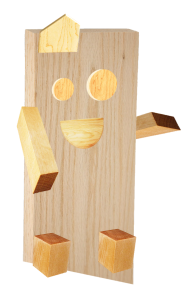
Kindergarten: The Katydids completed their treasure chests and are now thinking about all the different things we can put inside them. Using found objects from the class collection of interesting things each student selected one item. We made observational drawings of the chosen object and then started to add to it—imagining it as a part of something larger and more complex. Almost like a relic from some treasure, a thing that could tell a story about something that was no longer there. What could this button be? The control panel from a robot? The eye of a fantastical beast? A jewel in a crown? And this bit of shiny metal? And this broken plastic thing-a-majig? Using wood, nails and saws each student is building her os his imagined object, creature, machine and more. We will continue exploring the different functions things may have and practice our woodworking skills.
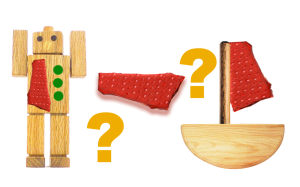
First Grade: The Centipedes wrapped up their city project this month. After completing our buildings, rocket launchers, dance halls, pools, castles and all the other amazing buildings the city needed we painted them and each student did a bit of urban planning. Each student used a board on which she or he planned, designed and painted the environment for their building. We added grass, roads, parking lots and more. To complete the project we made some trees. Using branches, each student sawed lengths of wood and attached them to bases so we could place them throughout the city. We added crumpled paper canopies to complete our trees. The Centipedes will now connect all the parts to form one large city which we have yet to name… In the spirit of collaboration and with construction in mind the class is now working on a large-scale sign for the wood shop door. Each student was assigned on letter to spell out: “THE CO-OP WOOD SHOP.” Using a single length of wood each student had to consider what it would take to make her or his letter. How many pieces would you need? What should their lengths be? Do they all need to be the same? What is the best way to mark and cut the wood and so on. We then tackled the question of what would be the best way to attach the pieces to each other and to the board. The Centipedes are coming up with many different great solutions and once the letters are in place we can decorate them and put them as one big sign.
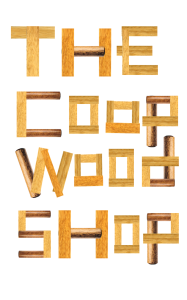
Second Grade: The Sharks finished their “subway train of the future.” They colored their subway cars, added hardware—eyes and hooks—at the front and backs of their car so that they could attach to eachother and for one long amazing train. Finally, the Sharks made tracks for their train—it was wonderful to see it all come together. In anticipation of the Shark’s production of Charlie and the Chocolate Factory the class has taken on the role of stage and prop designers. This new theater crew is working hard making huge lollipop flowers for the chocolate factory and will soon make the Wonka Factory gates, the Bucket house set, a chocolate river, a huge TV, machines for the gum room and more.
